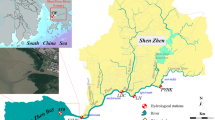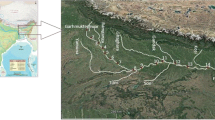Abstract
Effects of sediment extraction and dam construction on changes of riverbed characteristics over yearly to decadal scales in the lower Tedori River of Japan are clarified. Over 1950–1991, the riverbed degraded in excess of 0.5–3.5 m. Concurrently, riverbed sediment volume of the 0–16 km reach decreased by 12.7 × 106 m3. Intensive sediment extraction was the dominant cause of riverbed degradation during the period. During 1991–2007, an increase in riverbed sediment volume of 0.6 × 106 m3 resulted in accretion of the riverbed by average depth 0.04 m. The cessation of sand and gravel mining (SGM), coupled with Tedorigawa Dam operation since 1980, was responsible for that accretion. Temporal change in riverbed elevation during 1950–2007 indicates that there were five phases of vertical adjustment. Combination of nonlinear regression models described four of these phases well. During 1950–1979, the first four modes of empirical orthogonal function analysis successfully captured temporal and spatial responses of the riverbed to natural and anthropogenic impacts. That is, the first mode explained the mean riverbed profile and temporal variation in riverbed sediment volume. The second through fourth spatial eigenfunctions reflected spatial variation in vertical adjustment rate for phases II, III and I, respectively. The corresponding temporal eigenfunctions explained the respective effects on the riverbed of SGM, of imbalance between sediment transport capacity and sediment supply, and of dredging activity.







Similar content being viewed by others
References
Alekseevskiy NI, Berkovich KM, Chalov RS (2008) Erosion, sediment transportation and accumulation in rivers. Int J Sedim Res 23(2):93–105
Church M (1995) Geomorphic response to river flow regulation: case studies and time-scales. Regul Rivers Res Manag 11(1):3–22
Collins BD, Dunne T (1989) Gravel transport, gravel harvesting, and channel-bed degradation in rivers draining the southern olympic mountains, Washington, U.S.A. Environ Geol 13(3):213–224
Dang MH, Umeda S, Matsuda R, Yuhi M (2012) Influence of anthropogenic activities on the lower Tedori River, Japan. Japan Sea Res Kanazawa Univ 43:19–34
Dang MH, Umeda S, Yuhi M (2013) Human impact on morphology and sediment budget in the Tedori River, Japan. In: Fukuoka et al (eds) Advances in river sediment research, CRC Press, Boca Raton, pp 289–297
Dietrich WE, Kirchner JW, Ikeda H, Iseya F (1989) Sediment supply and the development of the coarse surface layer in gravel-bedded rivers. Nature 340:215–217
Erskine WD (1990) Environmental impact of sand and gravel extraction on river systems. In: Davie P, Stock E, Low Choy D (eds) The Brisbane River: a source book for the future. Australian Littoral Society Inc. and Queensland Museum, Brisbane, pp 295–302
Grant GE (2012) The geomorphic response of gravel-bed rivers to dams: perspectives and prospects. In: Gravel-bed Rivers. Wiley, New York, pp 165–181. doi:10.1002/9781119952497.ch15
HRDB (1985) Flood prevention project of Kanazawa office of HRDB. Hokuriku Regional Coordination Association, p 717 (in Japanese)
Hsu T-W, Jan C-D, Chang K-C, Wang S-K (2006) Analysis and prediction of riverbed changes using empirical orthogonal functions. J Hydraul Res 44(4):488–496
Huang G (2011) Time lag between reduction of sediment supply and coastal erosion. Int J Sedim Res 26(1):27–35
Isik S, Dogan E, Kalin L, Sasal M, Agiralioglu N (2008) Effects of anthropogenic activities on the Lower Sakarya River. Catena 75(2):172–181
Jang C, Shimizu Y (2005) Numerical simulation of relatively wide, shallow channels with erodible banks. J Hydraul Eng 131(7):565–575
Kondolf GM (1994) Geomorphic and environmental effects of instream gravel mining. Landsc Urban Plan 28:225–243
Kondolf GM (1997) Hungry water: effects of dams and gravel mining on river channels. Environ Manag 21(4):533–551
Kondolf GM, Swanson ML (1993) Channel adjustments to reservoir construction and gravel extraction along Stony Creek. Calif Environ Geol 21:256–269
Martín-Vide JP, Ferrer-Boix C, Ollero A (2010) Incision due to gravel mining: modeling a case study from the Gállego River, Spain. Geomorphology 117:261–271
Nunomoto H, Takase N, Kawaguchi T (1980) A study on mechanism of the riverbed variation in the Tedori River. In: Proceedings of the 35th annual meeting of JSCE, vol 35, no. 2, pp 350–351 (in Japanese)
Rinaldi M (2003) Recent channel adjustments in alluvial rivers of Tuscany, central Italy. Earth Surf Proc Land 28:587–608
Rinaldi M, Simon A (1998) Bed-level adjustments in the Arno River, central Italy. Geomorphology 22(1):57–71
Rinaldi M, Wyzga B, Surian N (2005) Sediment mining in alluvial channels: physical effects and management perspectives. River Res Appl 21:805–828
Simon A (1989) A model of channel response in disturbed alluvial channels. Earth Surf Proc Land 14(1):11–26
Surian N, Cisotto A (2007) Channel adjustments, bedload transport and sediment sources in a gravel-bed river, Brenta River, Italy. Earth Surf Process Landf 32(11):1641–1656. doi:10.1002/esp.1591
Teramoto A, Nakamura S, Tsujimoto T (2003) Change of bar formation and bank erosion in the Tedori River. Adv River Eng JSCE 9:329–334
Top** DJ, Rubin DM, Vierra LE Jr (2000) Colorado River sediment transport 1. Natural sediment supply limitation and the influence of Glen Canyon Dam. Water Resour Res 36(2):515–542
Tsujimoto T (1999) Fluvial processes in streams with vegetation. J Hydraul Res 37(6):789–803
Tsujimoto T, Teramoto A (2004) Transitional change in vegetation and bar-morphology comparison between gravel-bed river and sandy river. Adv Hydro Sci Eng 6:1–9
Wijnberg KM, Wolf FCJ (1994) Three-dimensional behaviour of a multiple bar system. In: Proceedings of coastal dynamics ‘94, ASCE, pp 59–73
Winant CD, Inman DL, Nordstorm CE (1975) Description of seasonal beach changes using empirical eigenfunctions. J Geophys Res 80(15):1979–1986
Wu W, He Z (2009) Effects of vegetation on flow conveyance and sediment transport capacity. Int J Sedim Res 24(3):247–259
Yamamoto Y, Kawai K, Takano T (2008) Sedimentation control of coastal zone with large-scale sandy beach. Proc Civil Eng Ocean JSCE 24:1339–1344 (in Japanese)
Yuhi M (2008) Impact of anthropogenic modifications of a river basin on neighboring coasts: case study. J Waterway Port Coast Ocean Eng 134(6):336–344
Yuhi M, Umeda S, Hayakawa K (2009) Regional analysis on the decadal variation of sediment volume in an integrated watershed composed of the Tedori River and the Ishikawa Coast, Japan. J Coast Res SI 56:1701–1705
Acknowledgments
The authors are grateful to the Hokuriku Regional Development Bureau, Ministry of Land, Infrastructure and Transport of Japan, for providing the field data. The study was partially supported by a Grant-in-Aid for Scientific Research from the Japan Society for the Promotion of Science. We express our sincere thanks to Mr. Ryosuke Matsuda for his kind support in preprocessing the data.
Author information
Authors and Affiliations
Corresponding author
Rights and permissions
About this article
Cite this article
Dang, M.H., Umeda, S. & Yuhi, M. Long-term riverbed response of lower Tedori River, Japan, to sediment extraction and dam construction. Environ Earth Sci 72, 2971–2983 (2014). https://doi.org/10.1007/s12665-014-3202-0
Received:
Accepted:
Published:
Issue Date:
DOI: https://doi.org/10.1007/s12665-014-3202-0




